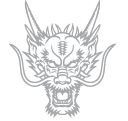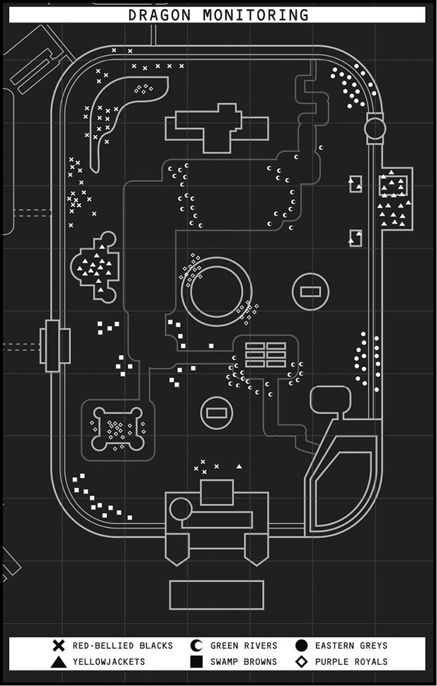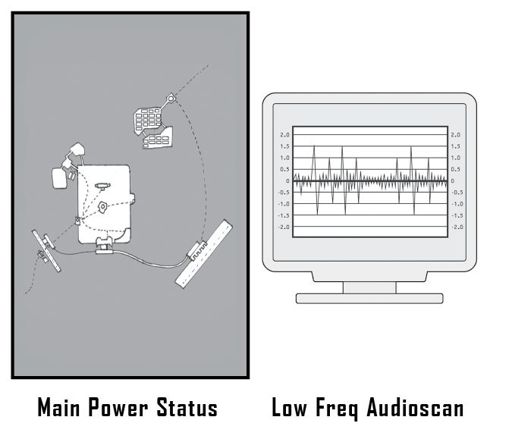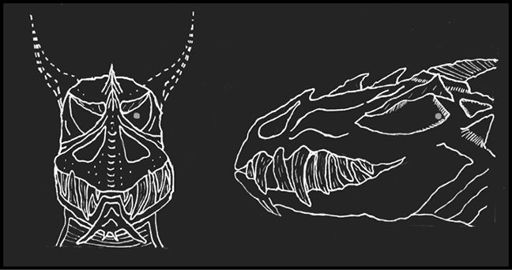The Great Zoo of China (9 page)
Read The Great Zoo of China Online
Authors: Matthew Reilly

‘And now the world warms again—more than it ever has in recorded history—and about forty years ago, a lone dragon emerged. We here at the Great Dragon Zoo of China were waiting when it did, for by chance we had found its nest. Come, let me show you how it happened.’
He clicked his fingers and right on cue—clearly as rehearsed—the five dragons took flight, leaping into the air with a great beating of wings.
CJ was surprised to see that the woman, Yim, now sat on Lucky’s back in a custom-made saddle. While Hu and Zhang had been speaking, she must have slipped it onto the dragon. Yim was
riding
the flying yellowjacket and with considerable skill, too. Handler and animal glided away over the view, flanked by the red-bellied black princes.
‘What a fucking show,’ Wolfe whispered to Perry.
CJ had to agree with him.

L
eaving the amphitheatre, Hu and Zhang led the group back to the glass elevators. They boarded an elevator and it descended briefly.
As the elevator eased downward, CJ whispered to Hamish, ‘What do you think, Bear?’
Hamish shrugged. ‘It’s all pretty cool and impressive . . . if you never saw fucking
Jurassic
Park
. Did you see the fangs on those things? How do we know they’re not gonna go all medieval on our asses and start munchin’ on the juicy little humans? I like old-fashioned zoos where they keep the animals in cages.’
After travelling only a few floors, the elevator stopped. The group was then led around a catwalk suspended high above the entry atrium, and into a room that looked like mission control at NASA.
Three broad descending levels containing perhaps thirty shirt-and-tie-wearing Chinese computer operators looked out over the megavalley through a perfectly circular three-storey-high window. Plasma screens and monitors were everywhere, displaying all kinds of graphs, charts and digital images. It was a kaleidoscope of blinking lights and data: the nerve centre of the Great Dragon Zoo.
‘This is our Master Control Room,’ Zhang said proudly.
CJ’s gaze was drawn to the biggest and most central monitor. On it was a huge white-on-black map of the zoo.
It was an animated map: scattered all over it were coloured icons—red crosses, yellow triangles, grey circles, and purple diamonds—many of them moving.

‘Every icon is a dragon?’ CJ asked Zhang.
‘Yes,’ he said. ‘In their infancy, each dragon was fitted with two microchips: one in the brain, the other grafted onto the animal’s heart. Those chips give us real-time data on the dragons’ heart rates, respiration rates, brain activity and other health information. The microchips are also GPS-capable, so we know where each dragon is at all times.’
Zhang grabbed a mouse and ran the cursor over one of the red crosses. Instantly, a text box appeared beside the cross. It read:
DRAGON ID: R-09
HEART RATE: 67 bpm
RESPIRATION RATE: 13.6 min
-1
O
2
CONSUMPTION: 0.06 ml g
-1
h
-1
The numbers changed constantly, giving data in real time. Impressive.
‘You can see the heart rate of every dragon in the zoo?’ CJ asked.
Zhang smoothed his tie again. ‘We want to maintain a close eye on the health of our animals. If any of them catches an infection, we want to detect it early, both to save the animal in question and prevent an epidemic spreading to the other dragons.’
Below the main map screen was a legend which allocated the coloured icons to names written in both Chinese and English:
RED-BELLIED BLACKS
YELLOWJACKETS
PURPLE ROYALS
EASTERN GREYS
GREEN RIVERS
SWAMP BROWNS
‘Nice names,’ Ambassador Syme said. ‘Catchy.’
‘Thank you,’ Hu said. ‘We hired a brand-consultancy firm in Los Angeles to come up with them. Of course, we have given the dragons formal Latin names—
Draconis imperator
,
Draconis rex
and the like—but this facility is built for tourists, not academics.’
CJ scanned the rest of the map.
She immediately noticed how icons of the same colour mostly appeared to cluster together.
The dragons stuck to their clans: red with red, yellow with yellow, and so on. It even looked like they had claimed their own territories: the purple ones dominated the central mountain, the red-bellied blacks the northwestern corner, the grey dragons the eastern slopes, while the yellowjackets appeared to live in two tight clusters on either side of the valley. The green and brown dragons lived almost exclusively in the rivers and the lakes.
CJ looked out through the giant circular window.
Like an enormous eye, it offered a commanding view of the zoo: the forests and lakes, the high central mountain. Once again, off to the left, she saw the two castles. The nearer one was beautiful, white and clean, with many fluttering banners, while the more distant one, erected on the western side of a curving waterfall, was in ruins.
The beautiful white castle seemed to be populated by purple royal dragons. They lounged on its walls and curled lazily on its rooftops.
The second castle was more utilitarian: squat and defensive; all bricks, crenellations and arrow slits.
And it looked like a bomb had hit it.
Its battlements were crumbled. Its watchtowers had literally been torn apart. Lying in the maw of its gate, underneath its grim portcullis, like a cat with its head between its paws, was a huge yellowjacket emperor. Two prince-sized yellow dragons sat atop the castle’s two watchtowers like dutiful sentinels.
CJ nodded at the castles. ‘I like the castles. Nice touch.’
Zhang said, ‘Like any zoo, we try to give our animals places to nest, sleep, hide and hunt in. Some of our structures resemble naturally occurring landscapes—caves, dens, glens—while others, like the castles, well,’ he shrugged bashfully, ‘they are more theatrical and designed with our human guests in mind.’
Off to CJ’s right was a many-storeyed hotel with an adjoining amusement park. A rollercoaster twisted and turned all around it, starting at the top of the hotel and sweeping down into the amusement park. It looked like it had been lifted straight out of Vegas and dropped here.
‘Hours of fun for the whole family,’ Hamish said as he took more shots with his camera.
‘Yes,’ Zhang said enthusiastically, not sensing the sarcasm.
CJ’s eyes ran over some of the other monitors in the master control room. She saw one which looked like an overhead map of the crater and its surrounds, and another that looked like a seismograph:

She was about to ask about them when Hamish said to Hu, ‘Hey, dude, I don’t want to be the jerk who asks the obvious question, but what’s keeping your pet lizards inside this crater? There’s no roof or cage above this valley. Why don’t they just fly out of here?’
Hu smiled kindly. ‘That is a very good question and this is the best place to answer it. Ladies and gentlemen, if I may draw your attention to this console over here . . .’ He stepped behind a Chinese technician at a computer.
On the computer’s screen was a digital image of the zoo:

‘Mr Cameron’s question,’ Hu said, ‘is a very astute one. When we conceived the Great Dragon Zoo, we didn’t want it to look like a prison. We wanted visitors to see our dragons as they were meant to be seen: soaring against the wide open sky.’
He held up a finger. ‘Having said that, our dragons are still very much our prisoners. As you will see on this display, there are two barriers—invisible to the human eye—keeping our dragons captive here inside the zoo.
‘They are electromagnetic fields. The first and innermost field is in the shape of a dome, the second is in the shape of a pyramid. The first covers only this valley, the second covers a much larger area
around
the valley. The two domes are essentially invisible walls of ultra-high-voltage electromagnetic energy. They also, I should add, extend underground, just in case our dragons attempt to tunnel their way out of here.
‘Now, as Deputy Director Zhang mentioned earlier, each dragon has a microchip grafted onto its brain.’
He indicated another nearby screen, on which was an x-ray image of a dragon skull seen from the front and from the side. CJ saw the chip situated immediately behind the left eye of the skull:

‘That chip,’ Hu said, ‘is actually fitted to the limbic or pain centre of the dragon’s brain and it is capable of emitting a powerful electric shock in certain circumstances. One of those circumstances is when a dragon comes into contact with either of the electromagnetic domes.’
CJ recalled the yellow remote from the trick show and wondered if that was another such ‘circumstance’.
Hu said, ‘If a dragon touches one of our domes, it will experience a shock sent directly into the pain centre of its brain. This, I can assure you, is an exceedingly painful experience.’
‘How painful?’ Wolfe asked.
‘If a dragon hits that dome,’ Hu said, ‘it will black out instantly and drop from the sky. The dragons learned very quickly not to touch the inner dome.’ He rounded on Hamish. ‘And, as a matter of fact, Mr Cameron, we did see
Jurassic Park
. From a very early stage in the development of this facility, we were cognisant of the dragons’ dangerous potential.